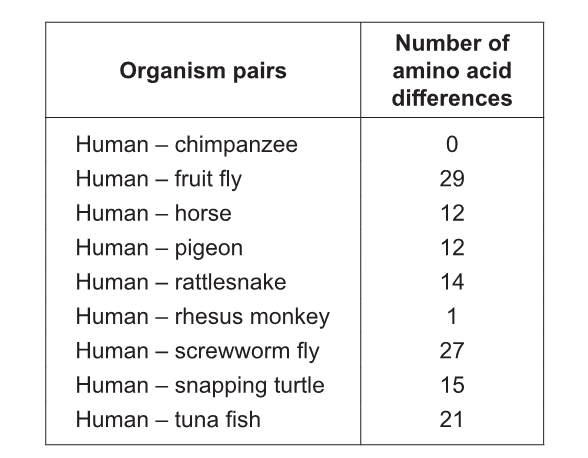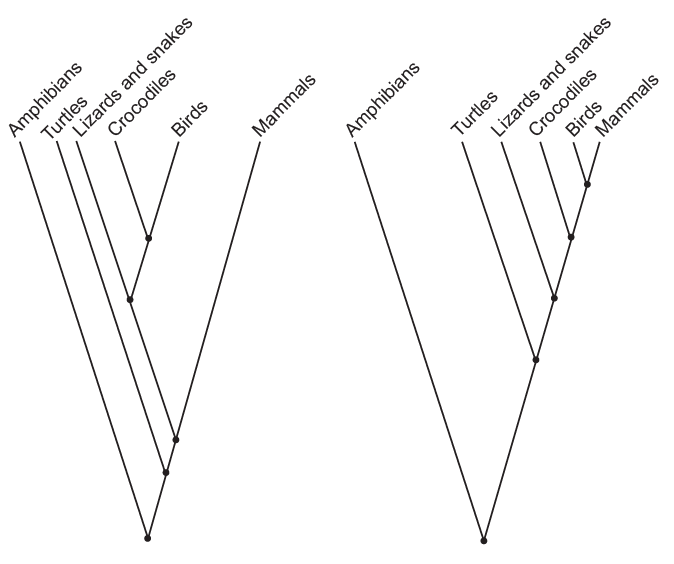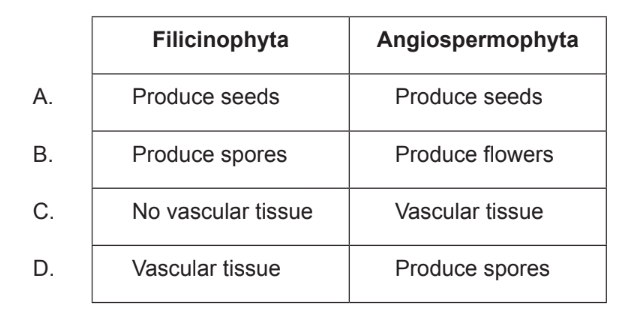IB Biology SL (Standard level)- 2024 – Practice Questions- All Topics
Topic 5.4 Cladistics
Topic 5 Weightage : 7%
All Questions for Topic 5.4 – Clades, Cladograms, Molecular Evidence, Structural Evidence, Clade Reclassification, In Situ Hybridisation, Mitochondrial DNA
Question
What information can be deduced from the sequence of nodes in a cladogram?
The geological period in which the species in the clade diverged from their common ancestor
The probable sequence of divergence among the species in the clade
The number of characteristics the species have in common
The number of mutations that have occurred since the species shared a common ancestor
▶️Answer/Explanation
Ans: B
The probable sequence of divergence among the species in a clade can be deduced from the sequence of nodes in a cladogram because each node represents a hypothetical common ancestor of the species that branch off from it. The order in which the nodes occur on the cladogram reflects the order in which the ancestral species diverged from one another. The most basal node represents the earliest common ancestor, while the most recent node represents the most recent common ancestor. By examining the sequence of nodes and the branching patterns on the cladogram, we can infer the evolutionary relationships and the probable sequence of divergence among the species in the clade.
Question
The table shows the number of differences between humans and other selected organisms for the protein cytochrome c oxidase. This protein, consisting of 104 amino acids, is located in the mitochondria and functions as an enzyme during cell respiration.

If the data were used to draw a cladogram, which chordates would be furthest apart from humans?
A. Chimpanzee because it has zero differences
B. Fruit fly because it has the most differences
C. Tuna fish because it is the chordate with the most differences
D. Horse because it is in the same class
▶️Answer/Explanation
C
If the data were used to draw a cladogram, the chordate that would be furthest apart from humans is the fruit fly because it has the most differences in the cytochrome c oxidase protein.
Therefore, the correct answer is B.
Option A is incorrect because chimpanzees are the closest living relatives of humans, with whom humans share a common ancestor.
Option C is incorrect because tuna fish is not the chordate with the most differences in the cytochrome c oxidase protein.
Option D is incorrect because horses are not the furthest apart from humans according to the data provided.
Cladograms can be created by comparing DNA or protein sequences. The cladogram on the left is based on DNA sequences and the cladogram on the right is based on comparing protein sequences.

What is the reason that cladograms based on DNA sequences are more reliable predictors of the phylogenetic relationship of species than cladograms based on protein sequences?
A. Amino acids are not as chemically stable as DNA nucleotides.
B. DNA mutates but amino acids do not.
C. Several different triplets of bases can code for the same amino acid.
D. There are 20 different amino acids but only 4 nucleotides
▶️Answer/Explanation
C
The reason that cladograms based on DNA sequences are more reliable predictors of the phylogenetic relationship of species than cladograms based on protein sequences is that several different triplets of bases can code for the same amino acid. Therefore, the same protein sequence can be produced by different DNA sequences.
Therefore, the correct answer is C.
Option A is incorrect because both amino acids and DNA nucleotides are chemically stable.
Option B is incorrect because both DNA and proteins can mutate.
Option D is incorrect because the number of nucleotides or amino acids does not affect the reliability of the cladogram.
Question
What is a recognition feature for both of the plant phyla indicated?

▶️Answer/Explanation
Ans:B
Angiosperms produce flowers, which are reproductive structures that contain both male and female parts. The male parts produce pollen, which is transferred to the female parts to fertilize the ovules and produce seeds. Filicinophytes, on the other hand, produce spores instead of flowers. These spores are produced in structures called sporangia, which are located on the undersides of the leaves. The spores are released into the air and can grow into new plants under the right conditions.
